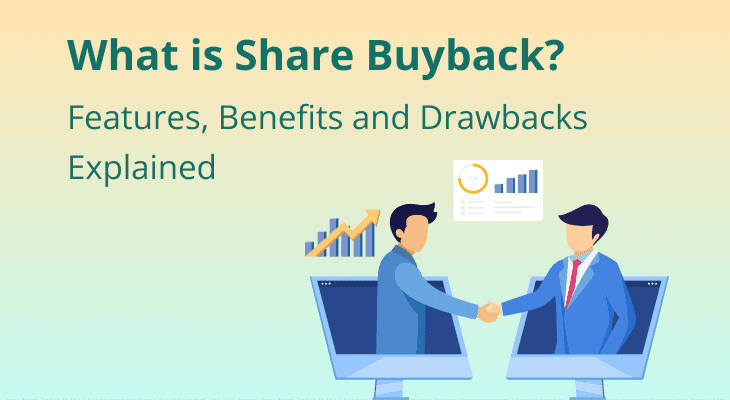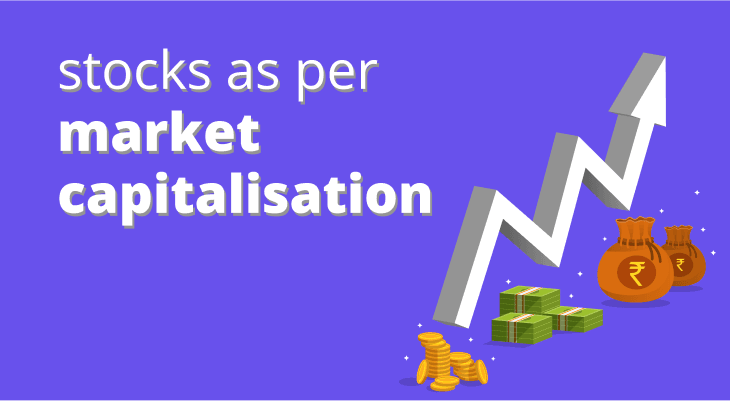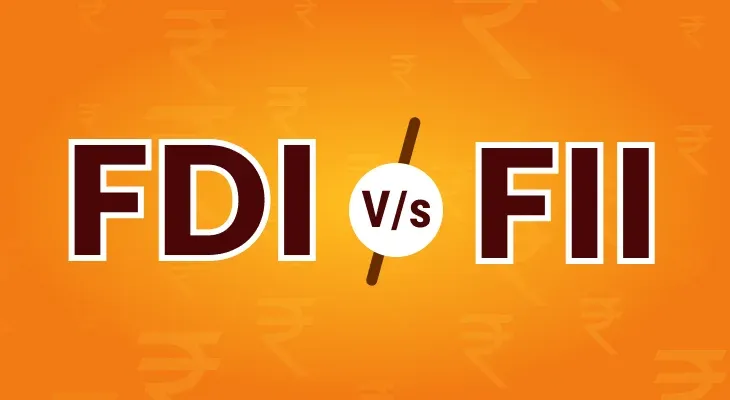
Share Buyback - Features, Benefits and Drawbacks
A share buyback, also known as stock buyback or share repurchase, occurs when a company buys back its shares from existing shareholders. It is a way for companies to reduce outstanding shares, and enhance shareholder value. But what exactly does a share buyback involve, and why is it significant for shareholders? Let’s explore share buyback meaning, its features, benefits, and potential drawbacks in detail.
What is Share Buyback?
A share buyback is a corporate action where a company purchases its shares from the open market or directly from shareholders. This reduces the number of shares in circulation, often leading to an increase in the value of remaining shares.
For example, if a company has 10 Lakh outstanding shares and decides to buy back 1,00,000 shares, the remaining 9,00,000 shares may gain in value due to increased earnings per share (EPS).
How Share Buyback Works
Here's a step-by-step explanation of how the process works:
1. Announcement:
The company publicly announces its intention to buy back shares. This announcement includes details like the buyback method (open market or tender offer), the maximum number of shares to be repurchased, the buyback price range, and the timeline.
2. Approval Process:
Share buybacks require approval from the board of directors. It also requires shareholder approval to comply with regulatory requirements under the Companies Act and SEBI regulations.
3. Funding the Buyback:
The company uses its surplus cash reserves. These are referred to as free reserves, which are not earmarked for any specific purpose. Companies with strong financial positions are more likely to conduct buybacks without taking on significant debt.
4. Execution of the Buyback:
- Open Market Buyback: The company purchases shares from the open market over a specific period at the prevailing market price. This is a flexible and the most common method used by companies.
- Tender Offer: The company offers to buy shares directly from shareholders at a premium price for a fixed number of shares. Shareholders can choose to sell their shares back to the company.
5. Reduction in Share Count:
Once the buyback is completed, the repurchased shares are cancelled. If cancelled, the total number of outstanding shares decreases, improving key metrics like earnings per share (EPS).
6. Impact on Shareholders:
Shareholders who sell their shares during the buyback receive money in exchange for their rights in the company’s assets. Remaining shareholders indirectly benefit from higher EPS and, in some cases, an increase in the share price due to reduced supply of the company's shares.
Read Also: Impact of Share Buyback on Shareholders
Reasons for Share Buyback
Companies undertake share buybacks for various strategic, financial, and operational reasons like
1. Optimising Capital Structure:
Companies often use share buybacks to adjust their debt-to-equity ratio. By reducing equity (outstanding shares), they improve this ratio, making the company more financially attractive.
2. Boosting Shareholder Value:
When a company buys back its shares, the reduced supply can lead to an increase in stock prices. Additionally, metrics like earnings per share (EPS) improve, which may attract more investors.
3. Surplus Cash Utilisation:
If a company has excess cash reserves and no immediate plans for investment or expansion, it may choose to return value to shareholders via a buyback rather than holding idle cash.
4. Price Discovery:
Companies believe their stock is undervalued in the market. A buyback price can act as an anchor for the market price of the company’s shares. A higher level signals confidence in the future performance of the company, which will make the shares more attractive for new investors.
5. Tax Efficiency:
Buybacks were originally taxed as dividends in the hands of shareholders. It still is taxed as a dividend, but the gross amount received on the buyback by the shareholders. This cost of acquisition of the shares are carried forward as capital loss to be set off against any capital gains earned by the taxpayer.
Add Additional Read - How is Dividend Income Taxed?
6. Defence Against Hostile Takeovers:
By reducing the number of shares available in the market, companies make it harder for a hostile acquirer to gain control. Buybacks can serve as a strategic tool to retain ownership.
7. Signal of Confidence:
Share buybacks are often viewed as a signal that the company is confident about its financial health and future prospects. It demonstrates that management believes the company is in a strong position.
8. Avoiding Dilution:
Buybacks can offset dilution caused by issuing stock options or convertible securities. By repurchasing shares, companies ensure existing shareholders maintain their proportional ownership.
9. Aligning Market Perception:
If the market undervalues a company’s shares due to temporary conditions, a buyback helps correct the price by reducing supply and boosting demand.
Example:
Suppose a company with surplus cash notices its share price has dropped significantly below its intrinsic value. The management initiates a buyback at ₹90 per share when its estimated value is ₹120. This not only boosts investor confidence but also benefits long-term shareholders by stabilising the price.
Types of Share Buyback Methods
A share repurchase can happen in different ways depending on the company’s strategy and direction. Here are a few common types of share buyback:
- Open Market Buyback: The company repurchases shares from the stock exchange at prevailing market prices. This method is the most popular one as it is flexible and allows for incremental purchases.
- Tender Offer Buyback: The company offers to buy shares directly from shareholders at a premium price. This method is more structured and faster. The shareholders have the option to sell or hold the shares.
- Dutch Auction Buyback: Shareholders specify the price at which they are willing to sell their shares within a price range set by the company. The shares are then bought at the highest price that aligns with the bid placed by the shareholders.
- Private Negotiation Buyback: Although not very common, sometimes the company negotiates directly with specific shareholders, often large investors, to repurchase shares.
Tax Implications of Share Buyback
The taxation rules surrounding share buybacks have evolved significantly over the years. Initially, shareholders were responsible for paying taxes on any capital gains earned through a company’s share buyback. These gains were calculated as the difference between the buyback price and the original purchase price of the shares.
Back then, companies distributing profits as dividends were subject to Dividend Distribution Tax (DDT). However, when companies opted for buybacks instead, the tax liability shifted to shareholders, making buybacks a tax-efficient alternative to dividends. This led many unlisted companies to favour share buybacks as a method of returning surplus funds to shareholders.
To address this tax advantage, the government introduced Section 115QA in 2013, imposing a tax on the distributed income from share buybacks for unlisted companies. This rule was later expanded in 2019 to include listed companies as well. Under this provision, the company conducting the buyback is liable to pay the tax. For example, if a company buys back shares worth ₹ 10 Cr and the tax rate is 20%, the company pays ₹ 2 Cr as tax, leaving ₹ 8 Cr distributed to shareholders.
To prevent double taxation, investors were exempt from paying taxes on their gains from buybacks under Section 10(34A) of the Income Tax Act, 1961. However, shareholders should still consider the implications of Section 14A, which could impact tax exemptions in certain scenarios. These provisions ensure that the tax burden is borne by the company conducting the buyback rather than the shareholders, while also preventing misuse of buybacks as a tax-avoidance tool.
Now buybacks are taxed at the gross amount received by shareholders from the company. The company deducts TDS and pays the tax to the government, while the shareholders pay tax on gross proceeds received from the company as dividend. The cost of acquisition of the shares are treated as capital loss which will be allowed to be set-off against other capital gains. In case there are no capital gains, it can be carried forward to subsequent years and set-off against capital gains in those years.
How Share Buyback Affects Stock Price
- Increase in Earnings Per Share (EPS): With fewer shares, the company’s profit per share rises, often boosting the stock price.
- Market Perception: A buyback indicates financial strength, leading to increased investor confidence.
- Short-term Price Volatility: While buybacks generally increase prices, they can also cause temporary fluctuations during execution.
Example:
If a company reports a net income of ₹50 crore and has 1 crore outstanding shares, its EPS is ₹50. After buying back 10 Lakh shares, the new EPS becomes ₹55.55 (₹50 crore / 90 lakh shares).
Share Buyback vs. Dividend Payments
Dividends are a portion of a company’s earnings distributed to shareholders as a reward for their investment, reflecting the company’s profitability and commitment to sharing wealth with its investors. While dividends and share buybacks are both methods of returning value to shareholders, they differ significantly in their approach and implications. Here’s a summary:
Aspect | Share Buyback | Dividend Payment |
Who Benefits? | Shareholders who sell their shares. | All shareholders, depending on the dividend payout ratio. |
Distribution Method | Company repurchases shares from shareholders. | Paid directly to shareholders as cash or stock dividends. |
Impact on Ownership | Increases the ownership percentage of remaining shareholders as the total share count decreases. | No impact on ownership percentage. |
Signal to Investors | Indicates that the company believes its stock is undervalued and has confidence in its future performance. | Reflects consistent profitability and financial stability. |
Financial Health | Reduces the company's cash reserves, but can improve financial metrics like EPS (Earnings Per Share). | Indicates the company has sufficient funds to reward shareholders, but may limit funds for reinvestment. |
Earnings Per Share (EPS) | EPS increases. | EPS remains unaffected. |
Total Number of Shares | Decreases. | Remains unchanged. |
Taxation | Tax-efficient for shareholders. | Taxed as income in the hands of shareholders. |
Drawbacks of Share Buyback
- Risk of Overvaluation: If the stock is not undervalued, a buyback can lead to capital misallocation.
- Reduced Liquidity: Fewer outstanding shares can reduce market liquidity, affecting trading volumes.
- Short-term Focus: Buybacks might prioritise short-term gains over long-term investments.
- Inequity Among Shareholders: Not all shareholders may participate equally in a tender offer buyback.
Conclusion
A share buyback is a powerful tool for companies to enhance shareholder value and demonstrate financial confidence. However, its effectiveness depends on market conditions, execution strategy, and company fundamentals. While it offers benefits like increased EPS and tax efficiency, it is not without its risks, such as overvaluation and liquidity concerns. Understanding the aspects of stock repurchase strategies and the company’s specific reasons is crucial for making informed investment decisions.
FAQ
What is a share buyback?
A share buyback, also known as a stock repurchase, is when a company buys back its shares from existing shareholders, reducing the total number of shares in circulation.
Why do companies opt for share buybacks?
Companies undertake buybacks to return surplus cash to shareholders, boost earnings per share, improve stock valuations, or signal confidence in their financial health.
How does a share buyback affect stock prices?
Share buybacks often lead to an increase in stock prices due to reduced share supply, improved earnings per share, and a positive market perception.
What are the types of share buyback methods?
Buybacks can be conducted through open market purchases, tender offers, or direct negotiation with large shareholders.
Are shareholders taxed on share buybacks?
Shareholders’ gross proceeds received from buybacks are taxed in the hands of the shareholders at their slab rate as dividend. The cost of acquisition of the shares are classified as capital loss and can be set off against other capital gains. Any balance capital loss can be carried forward to the subsequent years and set-off against capital gains in that year.
What is the difference between share buybacks and dividends?
Dividends provide direct cash payouts to shareholders, while buybacks reduce shares in circulation, indirectly benefiting shareholders through potential stock price increases.
Who benefits the most from a share buyback?
Shareholders who retain their shares post-buyback benefit from improved earnings per share and potentially higher stock prices.
Can share buybacks harm a company?
Yes, if a company uses excessive debt or diverts funds from critical investments to finance buybacks, it could hurt long-term growth and financial stability.
What signals do share buybacks send to investors?
Buybacks signal that management believes the stock is undervalued, demonstrating confidence in the company’s future prospects.
Are there any risks associated with share buybacks?
Risks include overleveraging to fund buybacks, reduced cash reserves, and potential mismanagement of capital, which can affect long-term growth.


